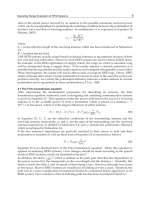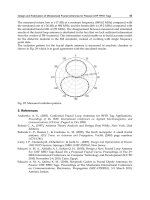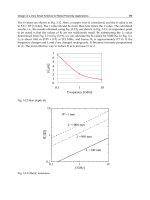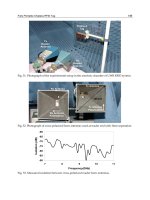Digital Systems Design and Prototyping: Using Field Programmable Logic and Hardware Description Languages pot
Bạn đang xem bản rút gọn của tài liệu. Xem và tải ngay bản đầy đủ của tài liệu tại đây (14.69 MB, 633 trang )
DIGITAL SYSTEMS DESIGN
AND PROTOTYPING
Using Field Programmable Logic
and
Hardware Description Languages
Second Edition
Digital Systems Design and Prototyping: Using Field Programmable
Logic and Hardware Description Languages, Second Edition includes a
CD-ROM that contains Altera’s MAX+PLUS II Student Edition
programmable logic development software. MAX+PLUS II is a fully
integrated design environment that offers unmatched flexibility and
performance. The intuitive graphical interface is complemented by
complete and instantly accessible on-line documentation, which makes
learning and using MAX+PLUS II quick and easy. MAX+PLUS II version
9.23 Student Edition offers the following features:
Operates on PCs running Windows 95/098, or Windows NT 4.0
Graphical and text-based design entry, including the Altera
Hardware Description Language (AHDL), VHDL and Verilog
Design compilation for product-term (MAX 7000S) and look-up
table (FLEX 10K) device architectures
Design verification with functional and full timing simulation
The MAX+PLUS II Student Edition software is for students who are
learning digital logic design. By entering the designs presented in the book
or creating custom logic designs, students develop skills for prototyping
digital systems using programmable logic devices.
Registration and Additional Information
To register and obtain an authorization code to use the MAX+PLUS II
software, go to: For complete
installation instructions, refer to the read.me file on the CD-ROM or to the
MAX+PLUS II Getting Started Manual, available on the Altera world-
wide web site ().
This CD-ROM is distributed by Kluwer Academic Publishers with
*ABSOLUTELY NO SUPPORT* and *NO WARRANTY* from Kluwer
Academic Publishers.
Kluwer Academic Publishers shall not be liable for damages in connection
with, or arising out of, the furnishing, performance or use of this CD-ROM.
DIGITAL SYSTEMS DESIGN
AND PROTOTYPING
Using Field Programmable Logic
and
Hardware Description Languages
Second Edition
Zoran Salcic
The University of Auckland
Asim Smailagic
Carnegie Mellon University
KLUWER ACADEMIC PUBLISHERS
NEW YORK, BOSTON, DORDRECHT, LONDON, MOSCOW
eBook ISBN: 0-306-47030-6
Print ISBN: 0-792-37920-9
©2002 Kluwer Academic Publishers
New York, Boston, Dordrecht, London, Mosh
The CD-ROM is only available in the print edition. Print ©2000 Kluwer Academic Publishers
All rights reserved
No part of this eBook may be reproduced or transmitted in any form or by any means, electronic,
mechanical, recording, or otherwise, without written consent from the Publisher
Created in the United States of America
Visit Kluwer Online at:
and Kluwer's eBookstore at:
v
Table of Contents
PREFACE TO THE SECOND EDITION XVI
1 INTRODUCTION TO FIELD PROGRAMMABLE LOGIC
DEVICES
1.1. Introduction
1.1.1
1.1.2
1.1.3
1.1.4
1.1.5
1.1.6
1.1.7
1.1.8
Speed
Density
Development Time
Prototyping and Simulation Time
Manufacturing Time
Future Modifications
Inventory Risk
Cost
1.2 Types of FPLDs
1.2.1
1.2.2
1.2.3
CPLDs
Static RAM FPGAs
AntifuseFPGAs
1.3 Programming Technologies
1.3.1
1.3.2
1.3.3
1.3.4
SRAM Programming Technology
Floating Gate Programming Technology
Antifuse Programming Technology
Summary of Programming Technologies
1.4. Logic Cell Architecture
1.5 Routing Architecture
1.6 Design Process
1.7 FPLD Applications
1.7.1
1.7.2
1.7.3
1.7.4
1.7.5
Glue Random Logic Replacement
Hardware Accelerators
Non-standard Data Path/Control Unit Oriented Systems
Virtual Hardware
Custom-Computing Machines
1
1
4
4
5
5
6
6
6
7
7
10
11
12
13
13
15
16
17
17
26
30
33
34
35
36
37
38
vi
1.8 Questions and Problems
2 EXAMPLES OF MAJOR FPLD FAMILIES
2.1 Altera MAX 7000 Devices
2.1.1
2.1.2
2.1.3
2.1.4
2.1.5
2.1.6
MAX 7000 devices general concepts
Macrocell
I/O Control Block
Logic Array Blocks
Programmable Interconnect Array
Programming
2.2 Altera FLEX 8000
2.2.1
2.2.2
2.2.3
2.2.4
2.2.5
2.2.6
2.2.7
Logic Element
Logic Array Block
FastTrack Interconnect
Dedicated I/O Pins
Input/Output Element
Configuring FLEX 8000 Devices
Designing with FLEX 8000 Devices
2.3 Altera FLEX 10K Devices
2.3.1
2.3.2
Embedded Array Block
Implementing Logic with EABs
2.4 Altera APEX 20K Devices
2.4.1
2.4.2
2.4.3
2.4.4
General Organization
LUT-based Cores and Logic
Product-Term Cores and Logic
Memory Functions
2.5 Xilinx XC4000 FPGAs
2.3.1
2.5.2
2.5.3
2.5.4
Configurable Logic Block
Input/Output Blocks
Programmable Interconnection Mechanism
Device Configuration
2.3.5
Designing with XC4000 Devices
2.6 Xilinx Virtex FPGAs
2.6.1
2.6.2
2.6.3
2.6.4
General Organization
Configurable Logic Block
Input/Output Block
Memory Function
39
39
43
44
46
49
50
52
53
54
55
61
62
65
65
67
72
75
75
77
80
82
82
84
87
91
92
95
97
100
101
102
103
103
105
106
43
vii
2.7 Atmel AT40K Family
2.7.1
2.7.2
2.7.3
2.6.4
General Organization
Logic Cell
Memory Function
Dynamic Reconfiguration
2.7 Problems and Questions
3 DESIGN TOOLS AND LOGIC DESIGN WITH FPLDS
3.1 Design Framework
3.1.1
3.1.2
Design Steps and Design Framework
Compiling and Netlisting
3.2 Design Entry and High Level Modeling
3.2.1
3.2.2
3.2.3
Schematic Entry
Hardware Description Languages
Hierarchy of Design Units - Design Example
3.3 Design Verification and Simulation
3.4 Integrated Design Environment Example: Altera's Max+Plus II
3.4.1
3.4.2
3.4.3
3.4.4
Design Entry
Design Processing
Design Verification
Device Programming
3.5
3.6
4
System prototyping: Altera UP1 Prototyping Board
Questions and Problems
INTRODUCTION TO DESIGN USING AHDL
4.1. AHDL Design Entry
4.1.1
4.1.2
AHDL Design Structure
Describing Designs with AHDL
4.2. AHDL Basics
4.2.1
4.2.2
4.2.3
4.2.4
Using Numbers and Constants
Combinational Logic
Declaring Nodes
Defining Groups
107
107
109
111
112
112
115
115
116
116
120
121
122
125
129
131
133
134
137
139
139
142
143
143
144
145
146
146
149
150
151
viii
4.2.5
4.2.6
4.2.7
4.2.8
Conditional Logic
Decoders
Implementing Active-Low Logic
Implementing Bidirectional Pins
4.3 Designing Sequential logic
4.3.1
4.3.2
4.3.3
4.3.4
4.3.5
4.3.6
Declaring Registers and Registered Outputs
Creating Counters
Finite State Machines
State Machines with Synchronous Outputs – Moore Machines
State Machines with Asynchronous Outputs – Mealy Machines
More Hints for State Machine Description
4.4 Problems and Questions
5
5.1
5.2
5.3
ADVANCED AHDL
Names and Reserved Keywords and Symbols
Boolean Expressions
Primitive Functions
5.3.1 Buffer Primitives
5.3 2 Flip-flop and Latch Primitives
5.3.3
5.3.4
5.3.5
Macrofunctions
Logic Parameterized Modules
Ports
5.4 Implementing a Hierarchical Project Using Altera-provided
Functions
5.5 Creating and Using Custom Functions in AHDL
5.5.1
5.5.2
5.5.3
Creation of Custom Functions
In-line References to Custom Functions
Using Instances of Custom Function
5.6 Using Standard Parameterized Designs
5.6.1
5.6.2
Using LPMs
Implementing RAM and ROM
5.7 User-defined Parameterized Functions
152
154
156
157
159
159
162
163
168
171
172
177
185
185
188
191
191
194
195
197
198
199
204
205
207
209
210
210
212
213
ix
5.8
5.9
Conditionally and Iteratively Generated Logic
Problems and Questions
6 DESIGN EXAMPLES
6.1 Electronic Lock
6.1.1
6.1.2
6.1.3
6.1.4
Keypad encoder
Input Sequence Recognizer
Piezo Buzzer Driver
Integrated Electronic Lock
6.2 Temperature Control System
6.2.1
6.2.2
6.2.3
6.2.4
6.2.5
Temperature Sensing and Measurement Circuitry
Keypad Control Circuitry
Display Circuitry
Fan and Lamp Control Circuitry
Control Unit
6.2.6 Temperature Control System Design
6.3 Problems and Questions
7 SIMP - A SIMPLE CUSTOMIZABLE MICROPROCESSOR
255
7.1 Basic Features
7.1.1
7.1.2
Instruction Formats and Instruction Set
Register Set
7.2
7.3
Processor Data Path
Instruction Execution
7.4 SimP Implementation
7.4.1
7.4.2
7.4.3
7.5 Questions and Problems
217
220
223
223
224
229
234
235
236
238
240
241
243
244
248
253
255
256
259
259
262
267
267
276
290
291
Data Path Implementation
Control Unit Implementation
Synthesis Results
8 RAPID PROTOTYPING USING FPLDS - VUMAN CASE
STUDY
295
8.1
8.2
8.3
8.4
8.5
System Overview
Memory Interface Logic
Private Eye Controller
Secondary Logic
Questions and Problems
9 INTRODUCTION TO VHDL
9.1
9.2
9.3
9.4
9.5
What is VHDL for?
VHDL Designs
Library
Package
Entity
9.6 Architecture
9.6.1
9.6.2
9.6.3
9.7
9.8
Configuration
Questions and Problems
10 OBJECTS, DATA TYPES AND PROCESSES
10.1 Literals
10.1.1
10.1.2
10.1.3
10.1.4
Character and String Literals
Bit, Bit String and Boolean Literals
Numeric Literals
Physical literals
295
298
305
311
311
313
314
317
320
321
322
324
326
327
328
329
330
333
334
334
335
336
336
Behavioral Style Architecture
Dataflow Style Architecture
Structural Style Architecture
x
xi
10.1.5
10.1.6
Range Constraint
Comments
10.2 Objects in VHDL
10.2.1
10.2.2
10.2.3
10.2.4
10.2.5
Names and Named Objects
Indexed names
Constants
Variables
Signals
10.3 Expressions
10.4 Basic Data Types
10.4.1
10.4.2
10.4.3
10.4.4
10.4.5
10.4.6
10.4.7
Bit Type
Character Type
Boolean Type
Integer Type
Real Types
Severity_Level Type
Time Type
10.5 Extended Types
10.5.1
10.5.2
10.5.3
Enumerated Types
Qualified Expressions
Physical Types
10.6 Composite Types - Arrays
10.6.1
10.6.2
Aggregates
Array Type Declaration
10.7
10.8
Records and Aliases
Symbolic Attributes
10.9 Standard Logic
10.9.1
10.9.2
10.9.3
10.9.4
10.9.5
IEEE Standard 1164
Standard Logic Data Types
Standard Logic Operators and Functions
IEEE Standard 1076.3 (The Numeric Standard)
Numeric Standard Operators and Functions
10.10 Type Conversions
337
337
337
337
338
339
339
340
340
341
344
345
346
346
347
347
348
348
348
350
351
351
352
353
354
355
360
360
362
365
367
368
371
xii
10.11
10.12
Process Statement and Processes
Sequential Statements
10.12.1
10.12.2
10.12.3
10.12.4
10.12.5
10.12.6
10.12.7
10.12.8
Variable Assignment Statement
If Statement
Case Statement
Loop Statement
Next Statement
Exit Statement
Null statement
Assert Statement
10.13
10.14
Wait Statement
Subprograms
10.14.1
10.14.2
Functions
Procedures
10.15 Questions and Problems
11 VHDL AND LOGIC SYNTHESIS
11.1
11.2
Specifics of Altera’s VHDL
Combinational Logic Implementation
11.2.1
11.2.2
11.2.3
11.2.4
11.2.5
Logic and Arithmetic Expressions
Conditional Logic
Three-State Logic
Combinational Logic Replication
Examples of Standard Combinational Blocks
11.3 Sequential Logic Synthesis
11.3.1
11.3.2
11.3.3
11.3.4
Describing Behavior of Basic Sequential Elements
Latches
Registers and Counters Synthesis
Examples of Standard Sequential Blocks
11.4 Finite State Machines Synthesis
11.4.1
11.4.2
11.4.3
11.4.4
State assignments
Using Feedback Mechanisms
Moore Machines
Mealy Machines
374
376
376
377
377
379
380
380
381
381
382
384
385
386
387
391
391
392
393
398
401
405
408
415
416
418
421
425
431
433
436
440
441
xiii
11.5 Hierarchical Projects
11.5.1
11.5.2
Max+Plus II Primitives
Max+Plus II Macrofunctions
11.6
11.8
Using Parameterized Modules and Megafunctions
Questions and Problems
12 EXAMPLE DESIGNS AND PROBLEMS
12.1 Sequence Recognizer and Classifier
12.1.1
12.1.2
12.1.3
12.1.4
12.1.5
Input Code Classifier
Sequence Recognizer
BCD Counter
Display Controller
Circuit Integration
12.2 SART – A Simple Asynchronous Receiver-Transmitter
12.2.1
12.2.2
12.2.3
12.2.4
SART Global Organization
Baud Rate Generator
SART Transmitter
SART Receiver
12.3 Questions and Problems
13 INTRODUCTION TO VERILOG HDL
13.1
13.2
What is Verilog HDL?
Basic Data Types and Objects
13.2.1
13.2.2
13.2.3
13.2.4
Nets
Registers
Parameters
Literals
13.3 Complex Data Types
13.3.1
13.3.2
13.3.3
13.3.4
Vectors
Arrays
Memories
Tri-state
13.4 Operators
442
443
443
449
455
459
459
461
462
466
468
470
476
477
480
484
490
493
493
494
495
496
497
497
499
499
499
500
500
501
475
xiv
13.4.1
13.4.2
13.4.3
13.4.4
13.4.5
13.4.6
13.4.7
13.4.8
13.4.9
Arithmetic operators
Logical Operators
Relational Operators
Equality operators
Bitwise Operators
Reduction Operators
Shift Operators
Concatenation operator
Replication operator
13.5 Design Blocks and Ports
13.5.1
13.5.2
.Modules
Ports
13.6 Procedural Statements
13.6.1
13.6.2
Selection - if and case Statements
Repetition - for, while, repeat and forever Statements
13.7 Simulation Using Verilog
13.7.1
13.7.2
Writing to Standard Output
Monitoring and Ending Simulation
13.8 Questions and Problems
14 VERILOG AND LOGIC SYNTHESIS BY EXAMPLES
14.1
14.2
Specifics of Altera’s Verilog HDL
Combinational Logic Implementation
14.2.1
14.2.2
14.2.3
14.2.4
Logic and Arithmetic Expressions
Conditional Logic
Three-State Logic
Examples of Standard Combinational Blocks
14.3 Sequential Logic Synthesis
14.3.1
14.3.2
14.3.3
14.3.4
Describing Behavior of Basic Sequential Elements
Latches
Registers and Counters Synthesis
Examples of Standard Sequential Blocks
14.4 Finite State Machines Synthesis
14.4.1
14.4.2
Verilog FSM Example
Moore Machines
501
502
503
503
504
505
505
506
507
507
507
511
513
513
514
523
524
525
527
529
529
530
530
533
534
535
540
540
541
542
545
548
548
550
14.4.3 Mealy Machines
14.5 Hierarchical Projects
14.5.1
14.5.2
User Defined Functions
Using Parameterized Modules and Megafunctions
14.6 Questions and Problems
15 A VERILOG EXAMPLE: PIPELINED SIMP
15.1 SimP Pipelined Architecture
15.1.1
15.1.2
15.1.3
Memory conflicts
Stage Registers
Branching Instructions
15.2 Pipelined SimP Design
15.2.1
15.2.2
Data Path
Control Unit
15.3 Pipelined SimP Implementation
15.3.1
15.3.2
Data Path Design
Control Unit Design
15.4 Questions and Problems
GLOSSARY
SELECTED READING
WEB RESOURCES
INDEX
553
555
555
556
557
559
559
560
561
562
562
563
565
570
571
578
595
597
609
613
617
xv
xvi
PREFACE TO THE SECOND EDITION
As the response to the first edition of the book has been positive, we felt it was our
obligation to respond with this second edition. The task of writing has never been
easy, because at the moment you think and believe the manuscript has been
finished, and is ready for printing, you realize that many things could be better and
get ideas for further improvements and modifications. The digital systems design
field is such an area in which there is no end. Our belief is that with this second
edition we have succeeded to improve the book and performed all those
modifications we found necessary, or our numerous colleagues suggested to do.
This edition comprises a number of changes in an attempt to make it more readable
and useful for teaching purposes, but also to numerous engineers who are entering
the field of digital systems design and field-programmable logic devices (FPLDs).
In that context, the second edition contains seven additional chapters, updated
information on the current developments in the area of FPLDs and the examples of
the most recent developments that lead towards very complex system-on-chip
solutions on FPLDs. Some of the new design examples and suggested problems are
just pointing to the direction of system-on-chip. Number of examples is further
increased as we think that the best learning is by examples. Besides further
emphasis on AHDL, as the main language for design specification, a
further
extension of presentation of two other hardware description languages, VHDL and
Verilog, is introduced. However, in order to preserve complementarity with another
book “VHDL and FPLDs in Digital Systems Design, prototyping and
Customization” (Zoran Salcic, Kluwer Academic Publishers, 1998) presentation of
VHDL is oriented mostly towards synthesizable designs in FPLDs.
This book focuses on digital systems design and FPLDs combining them into an
entity useful for designers in the areas of digital systems and rapid system
prototyping. It is also useful for the growing community of engineers and
researchers dealing with the exciting field of FPLDs, reconfigurable, and
programmable logic. Our goal is to bring these areas to the students studying digital
system design, computer design, and related topics, as to show how very complex
circuits can be implemented at the desk. Hardware and software designers are
xvii
getting closer every day by the emerging technologies of in-circuit reconfigurable
and in-system programmable logic of very high complexity.
Field-programmable logic has been available for a number of years. The role of
FPLDs has evolved from simply implementing the system "glue-logic" to the ability
to implement very complex system functions, such as microprocessors and
microcomputers. The speed with which these devices can be programmed makes
them ideal for prototyping and education. Low production cost makes them
competitive for small to medium volume productions. These devices make possible
new sophisticated applications and bring-up new hardware/software trade-offs and
diminish the traditional hardware/software demarcation line. Advanced design tools
are being developed for automatic compilation of complex designs and routing to
custom circuits.
To our knowledge, this book makes a pioneering effort to present rapid
prototyping and generation of computer systems using FPLDs. Rapid prototyping
systems composed of programmable components show great potential for full
implementation of microelectronics designs. Prototyping systems based on FPLDs
present many technical challenges affecting system utilization and performance.
The book contains fifteen chapters. Chapter 1 represents an introduction into the
field-programmable logic. Main types of FPLDs are introduced, including
programming technologies, logic cell architectures, and routing architectures used
to interconnect logic cells. Architectural features are discussed to allow the reader to
compare different devices appearing on the market, sometimes using confusing
terminology and hiding the real nature of the devices. Also, the main characteristics
of the design process using FPLDs are discussed and the differences to the design
for custom integrated circuits underlined. The necessity to introduce and use new
advanced tools when designing complex digital systems is also emphasized. New
section on typical applications is introduced to show in the very beginning where
FPLDs and complex system design are directed to.
Chapter 2 describes the field-programmable devices of the three major
manufacturers in the market, Altera, Xilinx and Atmel. It does not mean that
devices from other manufacturers are inferior to presented ones. The purpose of this
book is not to compare different devices, but to emphasize the most important
features found in the majority of FPLDs, and their use in complex digital system
prototyping and design. Altera and Xilinx invented some of the concepts found in
major types of field-programmable logic and also produce devices which employ all
major programming technologies. Complex Programmable Logic Devices (CPLDs)
and Field-Programmable Gate Arrays (FPGAs) are presented in Chapter 2, along
with their main architectural and application-oriented features. Although sometimes
we use different names to distinguish CPLDs and FPGAs, usually with the term
FPLD we will refer to both types of devices. Atmel’s devices, on the other hand,
xviii
give an option of partial reconfiguration, which makes them potential candidates for
a range of new applications.
Chapter 3 covers aspects of the design methodology and design tools used to
design with FPLDs. The need for tightly coupled design frameworks, or
environments, is discussed and the hierarchical nature of digital systems design. All
major design description (entry) tools are briefly introduced including schematic
entry tools and hardware description languages. The complete design procedure,
which includes design entry, processing, and verification, is shown in an example of
a simple digital system. An integrated design environment for FPLD-based designs,
the Altera’s Max+Plus II environment, is introduced. It includes various design
entry, processing, and verification tools. Also, a typical prototyping system, Altera’s
UP1 board is described as it will be used by many who will try designs presented in
the book or make their own designs.
Chapter 4 is devoted to the design using Altera’s Hardware Description
Language (AHDL). First, the basic features of AHDL are introduced without a
formal presentation of the language. Small examples are used to illustrate its
features and how they are used. The readers can intuitively understand language
and its syntax by examples. The methods for design of combinatorial logic in
AHDL, including the implementation of bidirectional pins, standard sequential
circuits such as registers and counters, and state machines is presented.
Chapter 5 introduces more advanced features of AHDL. Vendor supplied and
user defined macrofunctions appear as library entities. The implementation of user
designs as hierarchical projects consisting of a number of subdesigns is also shown.
AHDL, as a lower level hardware description language, allows user control of
resource assignments and very effective control of the design fit to target either
speed or size optimization. Still, the designs specified in AHDL can be of
behavioral or structural type and easily retargeted, without change, to another
device without the need for the change of the design specification. New AHDL
features that enable parameterized designs, as well as conditional generation of
logic, are introduced. They provide mechanisms for design of more general digital
circuits and systems that are customized at the time of use and compilation of the
design.
Chapter 6 shows how designs can be handled using primarily AHDL, but also in
the combination with the more convenient schematic entry tools. Two relatively
simple design case studies, which include a number of combinational and sequential
circuit designs are shown in this chapter. The first example is an electronic lock
which consists of a hexadecimal keypad as the basic input device and a number of
LEDs as the output indicators of different states. The lock activates an unlock signal
after recognizing the input of a sequence of five digits acting as a kind of password.
The second example is a temperature control system, which enables temperature
xix
control in a small chamber (incubator). The temperature controller continuously
scans the current temperature and activates one of two actuators, a lamp for heating
or a fan for cooling. The controller allows set up of a low and high temperature limit
range where the current temperature should be maintained. It also provides the basic
interface with the operator in the form of hexadecimal keypad as input and 7-
segment display and couple of LEDs as output. Both designs fit into the standard
Altera’s devices.
Chapter 7 includes a more complex example of a simple custom configurable
microprocessor called SimP. The microprocessor contains a fixed core that
implements a set of instructions and addressing modes, which serve as the base for
more complex microprocessors with additional instructions and processing
capabilities as needed by a user and/or application. It provides the mechanisms to be
extended by the designers in various directions and with some further modifications
it can be converted to become a sort of dynamically reconfigurable processor. Most
of the design is specified in AHDL to demonstrate the power of the language.
Chapter 8 is used to present a case study of a digital system based on the
combination of a standard microprocessor and FPLD implemented logic. The
VuMan wearable computer, developed at Carnegie Mellon University (CMU), is
presented in this chapter. Examples of the VuMan include the design of memory
interfacing logic and a peripheral controller for the Private Eye head-on display are
shown. FPLDs are used as the most appropriate prototyping and implementation
technology.
Although AHDL represents an ideal vehicle for learning design with hardware
description languages (HDLs), it is Altera proprietary language and as such can not
be used for other target technologies. That is the reason to expand VHDL
presentation in the second part of the book. Chapter 9 provides an introduction to
VHDL as a more abstract and powerful hardware description language, which is
also adopted as an IEEE standard. The goal of this chapter is to demonstrate how
VHDL can be used in digital system design. A subset of the language features is
used to provide designs that can almost always be synthesized. The features of
sequential and concurrent statements, objects, entities, architectures, and
configurations, allow very abstract approaches to system design, at the same time
controlling design in terms of versions, reusability, or exchangeability of the
portions of design. Combined with the flexibility and potential reconfigurability of
FPLDs, VHDL represents a tool which will be more and more in use in digital
system prototyping and design. This chapter also makes a bridge between a
proprietary and a standard HDLs.
Chapter 10 introduces all major mechanisms of VHDL used in description and
design of digital systems. It emphasizes those feature not found in AHDL, such as
objects and data types. As VHDL is object oriented language, it provides the use of
xx
a much higher level of abstraction in describing digital systems. The use of basic
objects, such as constants, signals and variables is introduced. Mechanisms that
allow user own data types enable simpler modeling and much more designer
friendly descriptions of designs. Finally, behavioral modeling enabled by processes
as the basic mechanism for describing concurrency is presented.
Chapter 11 goes a step further to explain how synthesis from VHDL descriptions
is made. This becomes important especially for those who are not interested for
VHDL as description, documentation or simulation tool, but whose goal is
synthesized design. Numerous examples are used to show how synthesizable
combinational and standard sequential circuits are described. Also, finite state
machines and typical models for Moore and Mealy machine descriptions are shown.
In Chapter 12 we introduce two full examples. The first example of an input
sequence classifier and recognizer is used to demonstrate the use of VHDL in
digital systems design that are easily implemented in FPLDs. As the system
contains a hierarchy of subsystems, it is also used to demonstrate a typical approach
in digital systems design when using VHDL. The second example is of a simple
asynchronous receiver/transmitter (SART) for serial data transfers. This example is
used to further demonstrate decomposition of a digital system into its parts and
integration at a higher level and the use of behavioral modeling and processes. It
also opens addition of further user options to make as sophisticated serial
receiver/transmitter as required.
Chapter 13 presents the third hardware description language with wide spread
use in industry - Verilog HDL. Presentation of Verilog is mostly restricted to a
subset useful for synthesis of digital systems. Basic features of the language are
presented and their utilization shown.
Chapter 14 is oriented only towards synthesizable models in Verilog. A number
of standard combinational and sequential circuits is described by synthesizable
models. Those examples provide a clear parallel with modeling the same circuits
using other HDLs and demonstrate power and simplicity of Verilog. They also
show why many hardware designers prefer Verilog over VHDL as the language that
is primarily suited for digital hardware design.
Final Chapter 15 is dedicated to the design of a more complex digital system.
The SimP microprocessor, introduced in Chapter 7 as an example of a simple
general purpose processor, is redesigned introducing pipelining. Advantages of
Verilog as the language suitable for both behavioral and structural modeling are
clearly demonstrated. The pipelined SimP model represents a good base for further
experiments with the SimP open architecture and its customization in any desired
direction.
xxi
The problems given at the end of each chapter are usually linked to and require
extension to examples presented within that or other chapters. By solving them, the
reader will have opportunity to further develop his own skills and feel the real
power of both HDLs and FPLDs as implementation technology. By going through
the whole design process from its description and entry simulation and real
implementation, the reader will get his own ideas how to use all these technologies
in the best way.
The book is based on lectures we have taught in different courses at Auckland
University and CMU, various projects carried out in the course of different degrees,
and the courses for professional engineers who are entering the field of FPLDs and
CAD tools for complex digital systems design. As with any book, it is still open and
can be improved and enriched with new materials, especially due to the fact that the
subject area is rapidly changing. The complete Chapter 8 represents a portion of the
VuMan project carried out at Carnegie Mellon University. Some of the original
VuMan designs are modified for the purpose of this book at Auckland University.
A special gratitude is directed to the Altera Corporation for enabling us to try
many of the concepts using their tools and devices in the course of its University
Program Grant and for providing design software on CD ROM included with this
book. Also Altera made possible the opportunity for numerous students at Auckland
University to take part in various courses designing digital systems using these new
technologies. The thank also goes to a number of reviewers and colleagues who
gave valuable suggestions. We believe that the book will meet their expectations.
This book would not be possible without the supportive environment at Auckland
University and Carnegie Mellon University as well as early support from
Cambridge University, Czech Technical University, University of Edinburgh, and
Sarajevo University where we spent memorable years teaching and conducting
research.
At the end, when we analyze the final manuscript as it will be printed, the book
looks more as a completely new one than as the second edition of original one.
Still, as it owes to its predecessor, we preserved the main title. However, the subtitle
reflects its shift of the ballance to hardware description languages as we explained
in this preface.
Z. A. Salcic A. Smailagic
Auckland, New Zealand Pittsburgh, USA
1
INTRODUCTION TO FIELD
PROGRAMMABLE LOGIC DEVICES
Programmable logic design is beginning the same paradigm shift that drove the
success of logic synthesis within ASIC design, namely the move from schematics to
HDL based design tools and methodologies. Technology advancements, such as
0.25 micron
five
level metal processing and architectural innovations such as large
amount of on-chip memory, have significantly broadened the applications for Field-
Programmable Logic Devices (FPLDs).
This chapter represents an introduction to the Field-Programmable Logic. The
main types of FPLDs are introduced, including programming technologies, logic
cell architectures, and routing architectures used to interconnect logic cells.
Architectural features are discussed to allow the reader to compare different devices
appearing on the market. The main characteristics of the design process using
FPLDs are also discussed and the differences to the design for custom integrated
circuits underlined. In addition, the necessity to introduce and use new advanced
tools when designing complex digital systems is emphasized.
1.1. Introduction
FPLDs represent a relatively new development in the field of VLSI circuits. They
implement thousands of logic gates in multilevel structures. The architecture of an
FPLD, similar to that of a Mask-Programmable Logic Device (MPLD), consists of
an array of logic cells that can be interconnected by programming to implement
different designs. The major difference between an FPLD and an MPLD is that an
MPLD is programmed using integrated circuit fabrication to form metal
interconnections while an FPLD is programmed using electrically programmable
switches similar to ones in traditional Programmable Logic Devices (PLDs). FPLDs
can achieve much higher levels of integration than traditional PLDs due to their
more complex routing architectures and logic implementation. The first PLD
developed for implementing logic circuits was the field-Programmable Logic Array
(PLA). A PLA is implemented using AND-OR logic with wide input programmable
AND gates followed by a programmable OR gate plane. PLA routing architectures
2 CH1: Introduction to Field ProgrammableLogic Devices
are very simple with inefficient crossbar like structures in which every output is
connectable to every input through one switch. As such, PLAs are suitable for
implementing logic in two-level sum-of-products form. The next step in PLDs
development was introduction of Programmable Array Logic (PLA) devices with a
single level of programmability - programmable AND gates followed by fixed OR
gates. In order to allow implementation of sequential circuits, OR gates are usually
followed by flip-flops. A variant of the basic PLD architectures appears in several
today’s FPLDs. FPLD combines multiple simple PLDs on a single chip using
programmable interconnect structures. Today such combinations are known as
Complex PLDs (or CPLDs) with the capacities equivalent to tens of simple FPLDs.
FPLD routing architectures provide a more efficient MPLD-like routing where each
connection typically passes through several switches. FPLD logic is implemented
using multiple levels of lower fan-in gates which is often more compact than two-
level implementations. Building FPLDs with very high capacity requires a different
approach, more similar to Mask-Programmable Gate Arrays (MPGAs) that are the
highest capacity general-purpose logic chips. As a MPGA consists of an array of
prefabricated transistors, that are customized for user logic by means of wire
connections, customization during chip fabrication is required. An FPLD which is
the field-programmable equivalent of an MPGA is very often known as an FPGA.
The end user configures an FPGA through programming. In this text we use the
FPLD as a term that covers all field-programmable logic devices including CPLDs
and FPGAs.
An FPLD manufacturer makes a single, standard device that users program to
carry out desired functions. Field programmability comes at a cost in logic density
and performance. FPLD capacity trails MPLD capacity by about a factor of 10 and
FPLD performance trails MPLD performance by about a factor of three. Why then
FPLDs? FPLDs can be programmed in seconds rather than weeks, minutes rather
than the months required for production of mask-programmed parts. Programming
is done by end users at their site with no IC masking steps. FPLDs are currently
available in densities over 100,000 gates in a single device. This size is large
enough to implement many digital systems on a single chip and larger systems can
be implemented on multiple FPLDs on the standard PCB or in the form of Multi-
Chip Modules (MCM). Although the unit costs of an FPLD is higher than an MPLD
of the same density, there is no up-front engineering charges to use an FPLD, so
they are more cost-effective for many applications. The result is a low-risk design
style, where the price of logic error is small, both in money and project delay.
FPLDs are useful for rapid product development and prototyping. They provide
very fast design cycles, and, in the case that the major value of the product is in
algorithms or fast time-to-market they prove to be even cost-effective as the final
deliverable product. Since FPLDs are fully tested after manufacture, user designs do
not require test program generation, automatic test pattern generation, and design
for testability. Some FPLDs have found a suitable place in designs that require
CH1: Introduction to Field Programmable Logic Devices 3
reconfiguration of the hardware structure during system operation, functionality can
change “on the fly.”
An illustration of device options ratings, that include standard discrete logic,
FPLDs, and custom logic is given in Figure 1.1. Although not quantitative, the
figure demonstrates many advantages of FPLDs over other types of available logic.
Figure 1.1 Device options ratings for different device technologies
The purpose of Figure 1.1 and this discussion is to point out some of the major
features of currently used options for digital system design, and show why we
consider FPLDs as the most promising technology for implementation of a very
large number of digital systems.
Until recently only two major options were available to digital system designers.
•
First, they could use Small-Scale Integrated (SSI) and Medium-Scale
Integrated (MSI) circuits to implement a relatively small amount of logic
with a large number of devices.
•
Second, they could use a Masked-Programmed Gate Array (MPGA) or
simply gate array to implement tens or hundreds of thousands of logic gates
on a single integrated circuit in multi-level logic with wiring between logic









